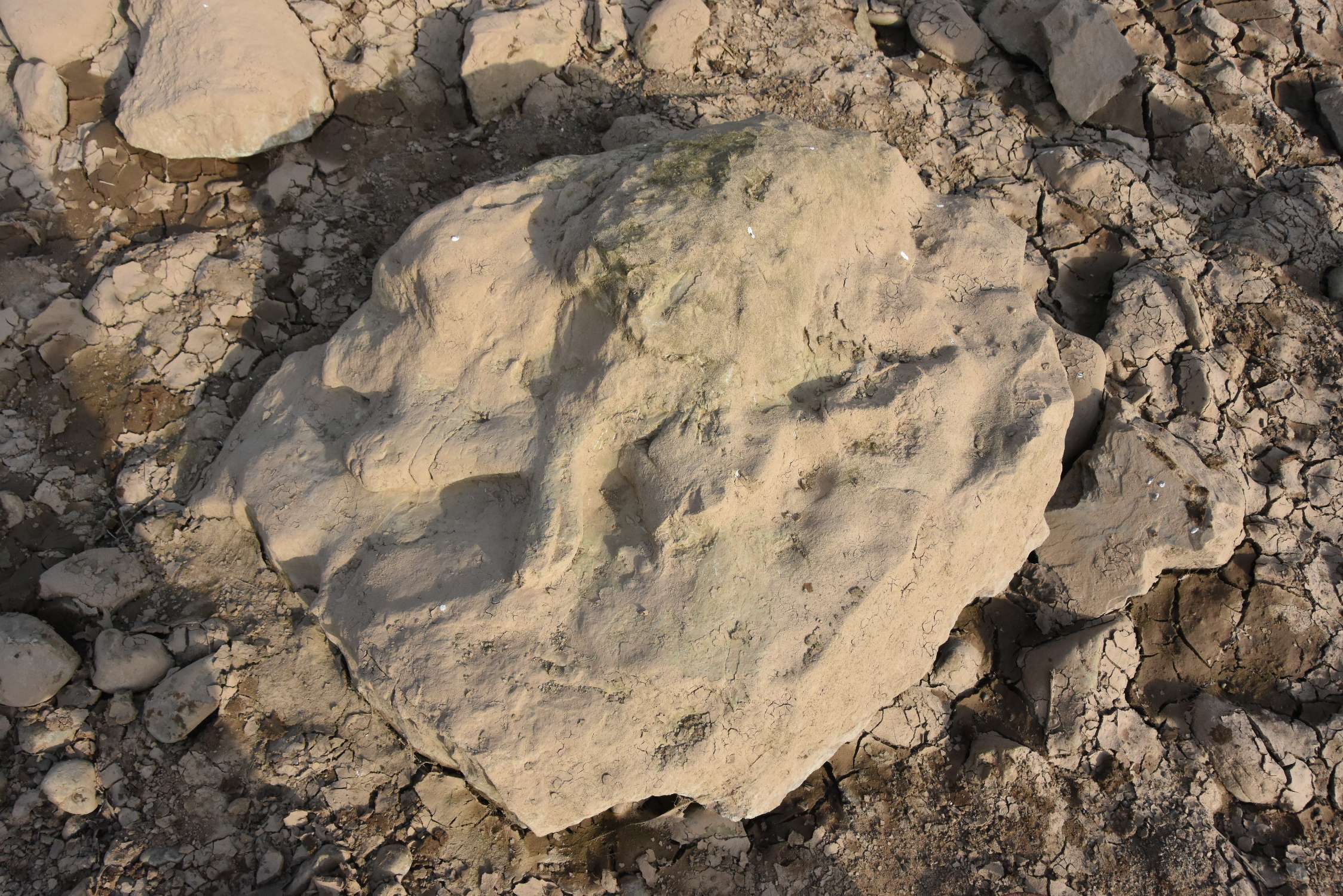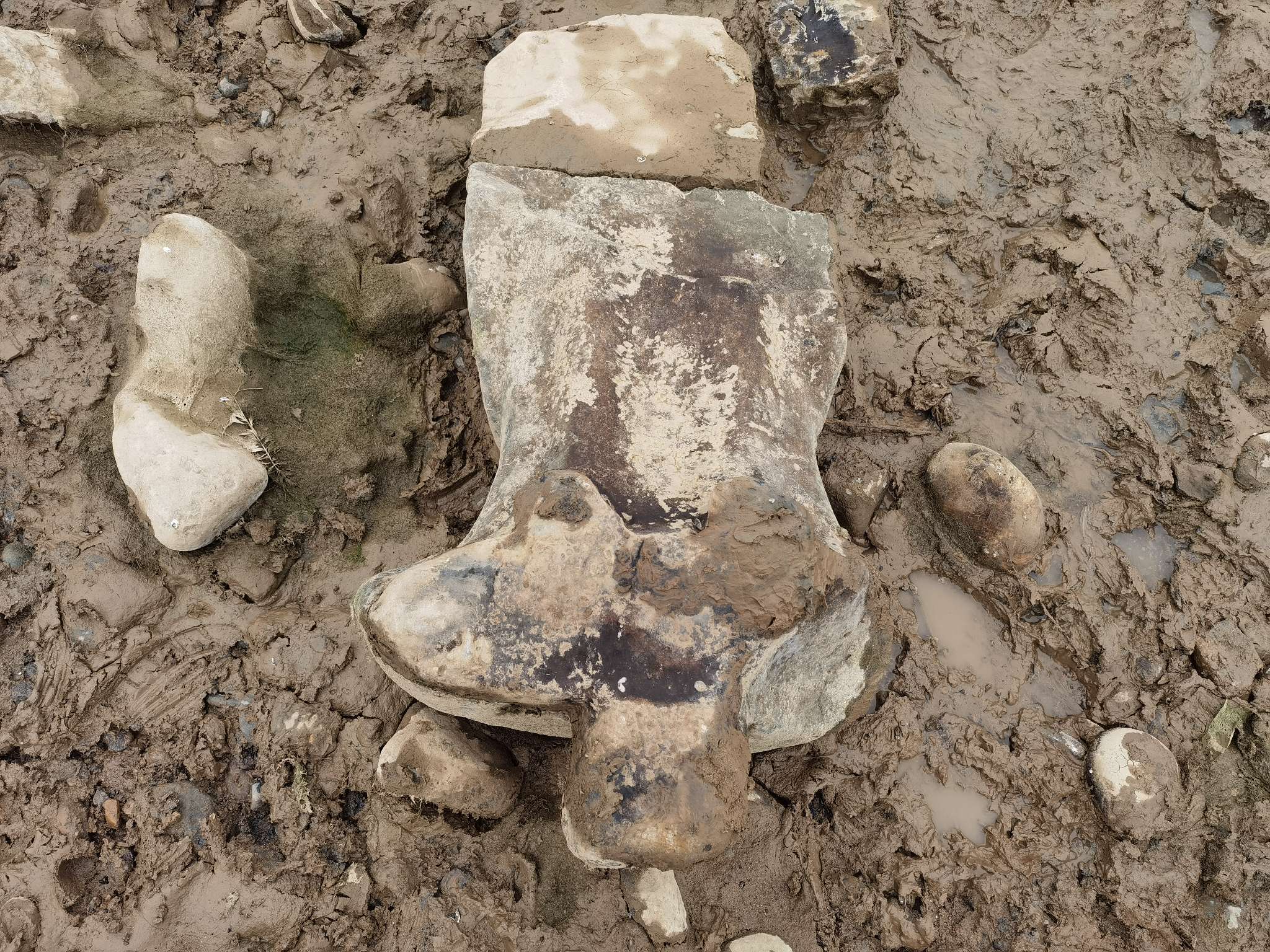Tang Dynasty Bodhisattva statues discovered from Yihe River near Longmen Grottoes
Tang Dynasty Bodhisattva statues discovered from Yihe River near Longmen Grottoes
龙门石窟伊河段发现唐代菩萨半身像
Archaeologists recently discovered a Bodhisattva bust of the Tang Dynasty (618-907) from the Yihe River near the Longmen Grottoes, said a source from the Longmen Grottoes Research Institute on March 20. Besides, two broken Bodhisattva statues were also discovered near a stone arch bridge of Longmen Grottoes.
3月20日,记者从龙门石窟研究院获悉,近日考古人员在龙门石窟景区伊河段发现了一尊唐代菩萨半身像,此外在龙门石拱桥下游不同位置也发现了两件残像。

A remnant of a Bodhisattva statue. [Photo provided to dahe.cn]
Recently, the scenic staff of the Longmen Grottoes refurbished the rubber dams and piers on the Yihe River. After the drainage, the riverbed of the river's eastern part became visible. On the morning of March 18, a staff member with years of maintenance work experience at Longmen Grottoes noticed a carved remnant among numerous broken stones, pebbles and silts on the riverbed. According to archaeologists at Longmen Grottoes Research Institute, it is believed to be a remnant of a Bodhisattva statue of the Tang Dynasty.
近日,龙门石窟景区伊河段排水后,工作人员在进行水面橡胶坝检修和游船码头施工时,河道的东半部有部分河床露出。3月18日早上,常年参与龙门石窟维护工程的一名工作人员在河道中踏查石块时,在河道遍布的大量碎石块、鹅卵石和淤泥中发现了疑似有人工雕凿痕迹残块。龙门石窟研究院考古人员立即到现场进行了详细勘查和石块表面淤泥、绿苔等的清理,发现是一件石雕造像,初步推测为一件唐代圆雕菩萨像残块。

A remnant of a Bodhisattva statue. [Photo provided to dahe.cn]
According to Lu Wei, director of the Research Center for History and Humanities of Longmen Grottoes Research Institute, the whole statue is cylindrical in shape and the remnant (below the statue's chest) is divided into two sections with a broken mark between the chest and abdomen. The statue has a skirt, with short embroidered cape hanging naturally, standing on a lotus seat. It seems that the statue also wears shoes. The front of the lotus seat is missing now, with a tenon beneath it. It is believed that the original statue should have a base with a mortise on it to ensure that the statue can be placed upright.
龙门石窟研究院历史人文研究中心主任路伟介绍,该造像呈圆柱状,中间有断痕,分为两段,整体为造像胸部以下,断裂处为胸、腹间,着裙,身体两侧有帔巾下垂,像足部立于仰莲座上,足部似着履,莲座前半部分已残,座下有榫头,该像完整时莲座下应该还有基座和榫卯窝,形成榫卯结构,造像可整体直立摆放。
The archaeologists also discovered two broken Bodhisattva statues near a stone arch bridge of Longmen Grottoes. One of them is carved on a large rock. Only the statue's legs and feet are preserved. The remnant is believed to be a Bodhisattva statue sitting cross-legged or in a joyful posture, with the upper body (above the statue's waist) missing. It has not been relocated due to its heavy weight and time constraints.
随后,考古人员又对龙门石拱桥下游进行了较大范围的普查和简单清理,在不同位置发现了2件残像。其中一件雕刻在一个较大型的山石上,可见造像的腿和双脚,初步推断为一交脚坐或游戏坐的菩萨像腰部以下及两脚部,腰部以上毁。因石块较大,时间紧,较难搬运,目前暂未搬离河道。

A remnant of a Bodhisattva statue. [Photo provided to dahe.cn]
The appearance of statues in the Yihe River can be attributed to two factors, according to Lu Wei.
石窟造像为何会在河道内出现?路伟认为可能有两方面原因:
On the one hand, the ancient Yihe River used to be with a large water flow once destroying temples. According to the historical document, "In February of 722 AD, the Yihe River was flooding, destroying Tianzhu and Fengxian temples located in the Longmen area." Fengxian Temple was a royal temple built with the decree of Emperor Gaozong (628-683) of the Tang Dynasty, responsible for the daily maintenance of the famous Vairocana Buddha. Some statues might be washed into the river with the destruction of the temple.
一方面是古代伊河水量较大,伊水泛涨曾冲毁过寺院。《旧唐书》载,“唐开元十年二月,伊水泛涨,毁都城南龙门天竺、奉先寺”。其中奉先寺是唐高宗敕建的皇家寺院,负责著名的大卢舍那像龛的日常洒扫和管理,寺院被冲毁也可能会有一些造像被冲入河道。
On the other hand, during the first half of the 20th century, the Longmen area was damaged by quarrying and theft, and some statues fell into the river and were washed downstream. Over the time, their surface has become smooth due to water erosion, but their decorations look less clear and exquisite now.
另一方面是,20世纪上半叶,龙门石窟一些区段被开山取石及盗凿破坏,窟龛造像也会掉入河道,长期水流冲刷、翻滚到下游。经千年或百年,造像表面在流水冲刷和翻滚碰撞下,会显得光滑或者表面纹饰有损伤导致雕刻细部不够清晰、精致。

A remnant of a Bodhisattva statue. [Photo provided to dahe.cn]
Over the years, Lu Wei has found four cultural relics in the Yihe River during dredging or tourism facility construction, all of which have been protected at Longmen Grottoes Research Institute. According to Lu Wei, these newly-discovered statues are very helpful for grotto research, since they can not only enrich the collections of Longmen Grottoes Research Institute, but also deepen the research on the historical and cultural connotation of the statues, including their artistic value, cultural connotation, and damages in the history.
多年来,在伊河河道疏浚或旅游设施施工中,路伟已经在河道中发现了4件文物,全部入藏龙门石窟研究院文物库房。路伟表示,这些新发现的造像,对石窟研究非常有帮助,一方面可以丰富龙门石窟研究院的藏品,另一方面也可以加深研究人员对龙门石窟造像历史文化内涵的研究,包括造像艺术、文化内涵、历史上毁坏及被盗凿破坏历史等研究。
"The Yihe River archaeological work is one of our main jobs, too. In the future, we will pay more attention to the projects and dredging of the Yihe River and strengthen our archaeological work, looking forward to more discoveries," said Lu Wei.
“围绕伊河河道相关工程开展的石窟造像考古工作,也是龙门考古人持续关注的方向之一。接下来,我们会更多关注伊河河道的这些工程和疏浚,加强伊河龙门段的河道考古,期待有更多新的发现。”路伟表示。(中文来源/大河网 记者/莫绍华 编译/杨佳欣 实习生/邱昌琪 李凯 李艳 审校/陈行洁)
